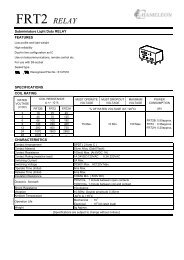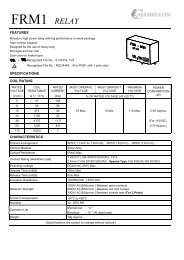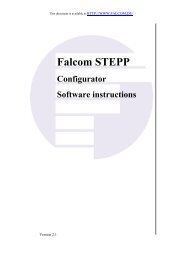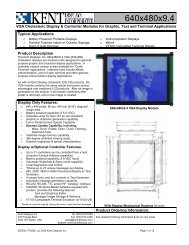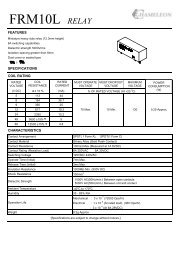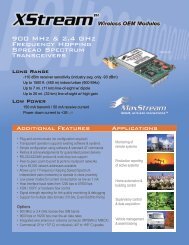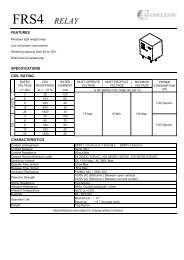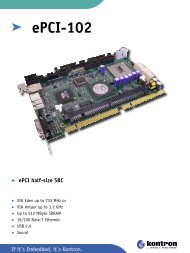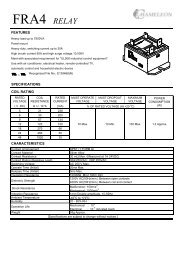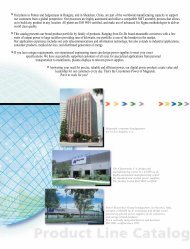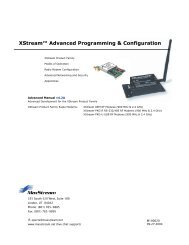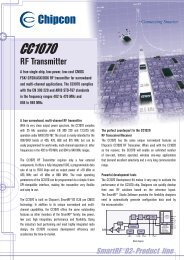STANDARD SERIAL COMMUNICATION INTERFACE and ...
STANDARD SERIAL COMMUNICATION INTERFACE and ...
STANDARD SERIAL COMMUNICATION INTERFACE and ...
You also want an ePaper? Increase the reach of your titles
YUMPU automatically turns print PDFs into web optimized ePapers that Google loves.
St<strong>and</strong>ard Serial Interface Protocol Description<br />
default font, each character will occupy a 8x10 pixel space. Up to 40 characters/text line <strong>and</strong><br />
up to 8 text lines/display can be output using this default font.<br />
f) (DC3) = Turn ON Underline control character. All characters entered in field 6 after the<br />
reception of this control character will be output in Underline format. The absence of<br />
this control character will comm<strong>and</strong> the respective sign to output the display with the<br />
default non-underlined mode.<br />
5.6.2 Maximum Number of 320x80 Messages<br />
As indicated in the “” references in table 5.6.1, the 320x80 controller module can store several<br />
messages or pages of data for the respective number of display assign to the controller module. To<br />
maximize the amount of messages to be stored in the controller module, the controller uses a dynamic<br />
memory allocation method. Each message type assign for each display with a given message (or<br />
“Page”) is allocated a fixed memory space, based on the message type for the given display. The<br />
dynamic memory allocation firmware uses a “link list” to place each display image in consecutive section<br />
of the controller RAM memory.<br />
The following memory space allocations are assigned to the available message types:<br />
# Message Type Field #4 Comm<strong>and</strong><br />
Designation(s)<br />
Fixed Memory<br />
Space Allocation<br />
1. Full Screen Text “0” 553 Bytes / Display image<br />
2. Full Screen Graphic “1” 3214 Bytes / Display image<br />
3. Partial Screen Text, Dynamic “2”, “4” <strong>and</strong> “6” 68 Bytes / Display image<br />
Update Text, Flashing Text<br />
4. Partial Screen Graphic “3” 2174 Bytes / Display image<br />
5 Dyanamic Update Partial Screen<br />
Graphic<br />
“5” 654 Bytes / Display image<br />
Table 5.6.2: Controller Memory Space Allocations for Different Types of Message Data<br />
As indicated previously, the 320x80 controller module will load display message data into memory<br />
sequentially, into the next available memory location. Since the controller has a finite amount of memory<br />
storage capacity, the interface software (“320x80Soft”, or equivalent) will need to either keep track of the<br />
amount of bytes used in the respective controller address prior to transmitting, or the controller will need<br />
to be “asked” the amount of available memory for an additional display message storage. For instance,<br />
the maximum amount of message data that can be loaded into a 320x80 controller can not exceed<br />
43,817 bytes.<br />
The following items pertain to maximizing the number of complete messages (or “pages”) stored by a<br />
320x80 controller module:<br />
o To maximize the number complete messages to be loaded into a controller module, use textbased<br />
messages (full, partial, flashing or partial screen text dynamic update) whenever possible.<br />
For instance, a 320x80 controller can store only 9 complete full screen graphic messages {3214<br />
[bytes/message] x 13 [messages] = 41,718 [bytes]}, whereas the same controller can store 79<br />
complete full screen text based message {553 [bytes/message] x 79 [messages] = 43,687<br />
[bytes]}, which is less than the 43,817 bytes capacity. Additional message storage capacity can<br />
be obtained if partial screen text images are used whenever possible.<br />
St<strong>and</strong>ard Serial Communication Interface Description, © 1998-2002 Kent Displays Inc., doc. # 25016 Revision T, Page 37 of 52



